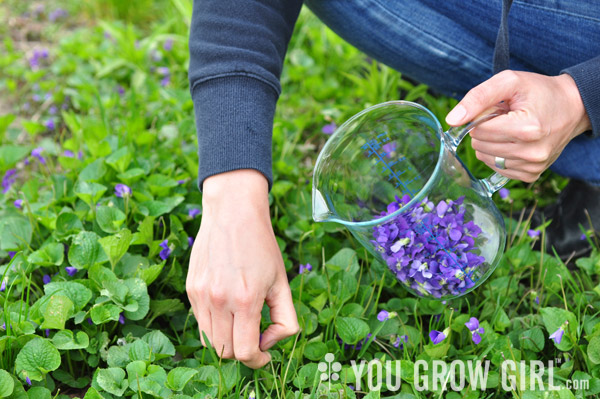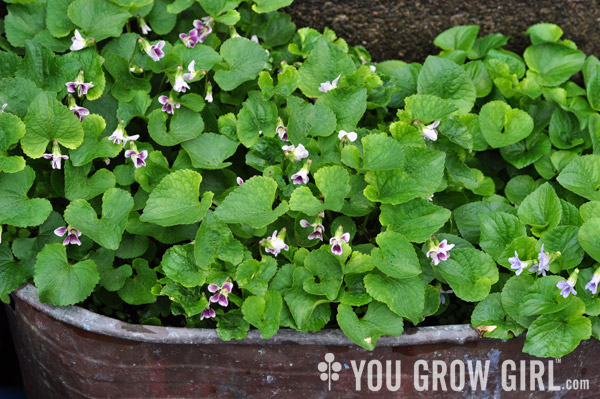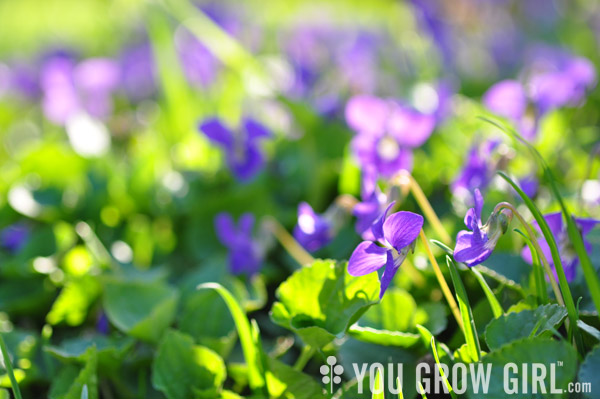
Violets (Viola odorata) and (V. sororia) are a spring flowering plant that really don’t get their due. In the midst of so many flashy, bold, spring blooms, they’re nearly forgettable. Violets are a “weed.” They pop up in lawns, aggressively claiming space pretty much wherever they want. They’re seen as “common,” and the generally held perception of them seems to be that they’re okay, and sure, yeah, they’re edible, but what do you do with them?
I love violets. When we moved here, they were one of the few plants in the yard that I was pleased to see and wanted to keep. I went to a questionable amount of effort to save them when we dug up the yard, and I expended even more energy separating them from clumps of grass before replanting.

This interesting cultivar is called ‘Alice Witter.’ I’ve been growing it in a big copper tub since I bought it several years ago when I was still growing on the roof. Last year I finally got around to transferring it into the soil.
Why bother growing violets?
- Because they look great. They provide greenery early on that lasts through to the end of the season. And they don’t just bloom in purple. I have 8 different types growing in my garden so far and I know there are many more species and cultivars out there in a host of colours and patterns.
- Because they are effortless. Violets naturalize and spread, and they come back yearly, tolerating all manner of abuse. I find that they barely even need to be dug into the soil. I have also found that they will put up with my indecision. I have dug up and moved the same clumps endlessly with little fallout.
- Because they are one of a handful of reliable, perennial edibles that thrive in the shade. I kept a patch in the ever-darkening back corner of my community garden plot for this reason. They also tend to tolerate higher moisture levels than many other perennial edibles, but at the same time, I have been surprised by how well they do in dryer areas, too.
- The fresh leaves are a source of vitamins, specifically C and A.
- Because they are cheap and cheerful, and once established you’ll have lots to share with friends.

What Can I Do with Violets?
- Eat the flowers: They have an interesting floral flavour that lends itself to savoury and sweet use. I often toss mine whole into spring salads as a spot of colour, but they work equally well on top of ice cream or a cake. Harvest Tip: Choose flowers that are freshly open.
- Make violet flower simple syrup: Make an infusion of a few cups of fresh flowers in 1 cup water. Strain. Measure liquid and heat in a pan with equal parts sugar until completely dissolved. Store in the fridge. Use it to flavour sparkling water, sparkling wine, or cocktails. Pour onto ice cream.
- Make violet blossom jelly. Bury the flowers in a jar of granulated sugar to flavour. Candy violet flowers.
- Infuse into vinegar to capture their flavour (and bright colour) for savoury usage.
- Make an herbal tea: You can use either the flowers or the leaves or both. Leaves can be dried and used through the winter.
- Infuse violet blossoms in honey.
- Freeze violet blossoms in ice cubes for colourful drinks.
- Smush violet flowers into softened butter. Refrigerate and spread onto bread, scones, or other savoury treats.
- Smush violet flowers into softened butter with some rosewater (or orange blossom water) and honey. Refrigerate and spread onto sweet baked goods.
- Add fresh blooms to egg salad.
- Eat the leaves fresh: Violets are one of the first greens available to eat in the early spring. I use them to round out my spring salads and find that the plants growing in the deepest shade provide fresh, edible greens in the summer when many of my other greens have conked out for the season. Harvest Tip: Choose the softest, freshest leaves to eat. Mature violet leaves are too tough and fibrous.
- Eat the leaves very quickly sautéed with other greens.
Make sure your violets are actually fragrant before picking hundreds to make syrup–I just assumed I was going to end up with something floral and delicious, and did not.
Have any of your violets hybridized into new forms?
We had the same difficulty. The violets that grew abundant and wild in our lawn were un-scented. So we went to our local nursery and bought fragrant violets to plant out in the flower bed. I can’t tell the two Violet plants apart at first glance, but when I compared the flowers side by side, the fragrant ones are slightly larger in size and are more delicate looking with longer stems. This is probably due to the fact that we dump weed killer on the Violets that grow in the lawn. (They resist any weed killer that we’ve found, but I’m sure it effects their growth.) And, the sweet ones smell sweet, of course.
Because we have so many violets in the lawn, we do see some variation in color. We have seen pinkish ones and partial white ones, but you have to look for them. By the time all these wild Violets are blooming we cut the lawn and the flowers are gone.
Sam Webb, Men’s Garden Club of Pittsburgh
Violets are pretty, hardy, a sure sign of the coming growing season and require no up-keep! I had a lovely large patch growning over my landlord’s ‘dumping’ area.This fall it was bulldozed down to hard clay-he wants a lawn, I want the violets back. MJ Horner
Thanks for all these inventive ideas!
I believe Violets are the larval food for one of the Fritillary butterflies, too, or maybe it’s a Mourning Cloak. I will have to look it up.
I love all the sweet violets in my yard. I’m in sunny and dry California and the sweet violets still make it through the summer with almost no water. While I can’t eat my violet flowers (extremely high lead levels in the soil), I am hoping to make some solid perfume or infused body oil with the blossoms next spring.
This is so timely – I had a “micro greens” and violet flowers salad for dinner (“micro greens” because I needed to thin some rows of arugula, lettuce and kale). It was very colorful and pretty, and it’s the year’s first meal from the garden!
I love violets for all the reasons you describe: they grow easily, they thrive in the shade and they look good throughout the year. I like that they spread a bit, but they are not invasive; great for filling out patches in the shade garden.
Greeting from Buffalo, NY!
I love violets. I love their little violet faces. And yes, I sometimes eat them if they are homegrown.
Have a hard time just looking at them as if they are a weed. They’re so sweet =) And like I said,………they have faces!!!
Where do you find the violets to purchase? I have been looking for Freckles and Alice Witter and cannot find anywhere that sells them?
I believe I bought them both at Lost Horizons http://losthorizons.ca/
Does all this hold for violas?
No. There are many differences.
Violets are my favorite flowers of all – I love their humble beauty and the delicious scent of viola odorata. I grow some of the cultivars too, but they in my experience they are not as scentented. Thank you for the great tips on how to use them! I love using edible flowers in the kitchen and have several recipes on the blog as well.
When I see violets in my yard I always recite this poem from my childhood: “Who bends a knew where violets grow, a hundred secret things shall know”. Sorry, don’t know the author but I think it’s charming and so are violets!
Rachel Field
I am relatively new to gardening. My family has a back “garden” that hasn’t been tended in probably 5 years, and I want to try to save it. I have been starting to weed and clear flower beds and prune and stuff, but the lawn is very uneven and there are all different kinds of plants in it. My brother wants to put black sheet things over the lawn during the summer and kill all the plants to start fresh, and I was wondering if there was a better way of doing it where we wouldn’t have to kill everything? I could always just dig up all the weeds and fill in holes and plant new grass but I was wondering what you guys would recommend?
Audrey- you can try the “lasagna method” to make new beds where you’d like if you don’t want to go digging up the whole garden (or covering everything with a black sheet). Where you want to kill off weeds or even out the ground for planting, just cover the ground with a couple layers of wet newspaper, grass clippings, cardboard and compost. Do a bit of research and see what combination of things you have handy to use for your layers. If you put a few inches of compost down on top you can start planting this season. Otherwise, it should all be decomposed and you’ll have super enriched soil for next spring. Super easy and no digging!
My “lawn” is filled with violets. We’ve don’t fertilize or use weed-killer but let whatever is green grow and then mow it. In the spring, the violets make a purple haze across the lawn that is just lovely, and they are tough as nails in the area of the lawn that floods in heavy rain. Combined with microclover, they are soft to walk on, resist our three dogs digging and pee, stay green all season, and are generally a great grass alternative.
The flowers are wonderful in salad, and especially pretty mixed with the yellow flowers from my mustard that goes to seed at the same time. I’m so excited to eat the leaves too.
Now if I could just find a way to keep them out of the flower and vegetable beds…
Another thing that you could do with edible flowers is to crystallize them and use it for decorations on desserts or even eat it with salads. Simply dip them in egg white, and coat them with sugar, either brown or caster sugar works fine, and leave them to dry approximately 24-48 hours. Tastes really great and at times I eat it just as snacks!